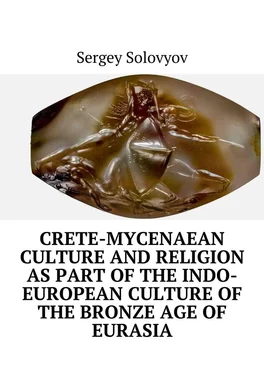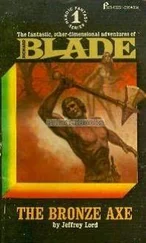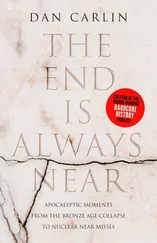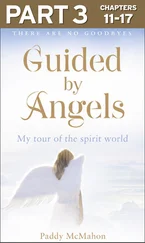Sergey Solovyov - Crete-Mycenaean culture and religion as part of the Indo-European culture of the Bronze Age of Eurasia
Здесь есть возможность читать онлайн «Sergey Solovyov - Crete-Mycenaean culture and religion as part of the Indo-European culture of the Bronze Age of Eurasia» — ознакомительный отрывок электронной книги совершенно бесплатно, а после прочтения отрывка купить полную версию. В некоторых случаях можно слушать аудио, скачать через торрент в формате fb2 и присутствует краткое содержание. ISBN: , Жанр: Философия, История, на английском языке. Описание произведения, (предисловие) а так же отзывы посетителей доступны на портале библиотеки ЛибКат.
- Название:Crete-Mycenaean culture and religion as part of the Indo-European culture of the Bronze Age of Eurasia
- Автор:
- Жанр:
- Год:неизвестен
- ISBN:9785449066442
- Рейтинг книги:3 / 5. Голосов: 1
-
Избранное:Добавить в избранное
- Отзывы:
-
Ваша оценка:
- 60
- 1
- 2
- 3
- 4
- 5
Crete-Mycenaean culture and religion as part of the Indo-European culture of the Bronze Age of Eurasia: краткое содержание, описание и аннотация
Предлагаем к чтению аннотацию, описание, краткое содержание или предисловие (зависит от того, что написал сам автор книги «Crete-Mycenaean culture and religion as part of the Indo-European culture of the Bronze Age of Eurasia»). Если вы не нашли необходимую информацию о книге — напишите в комментариях, мы постараемся отыскать её.
Crete-Mycenaean culture and religion as part of the Indo-European culture of the Bronze Age of Eurasia — читать онлайн ознакомительный отрывок
Ниже представлен текст книги, разбитый по страницам. Система сохранения места последней прочитанной страницы, позволяет с удобством читать онлайн бесплатно книгу «Crete-Mycenaean culture and religion as part of the Indo-European culture of the Bronze Age of Eurasia», без необходимости каждый раз заново искать на чём Вы остановились. Поставьте закладку, и сможете в любой момент перейти на страницу, на которой закончили чтение.
Интервал:
Закладка:
Hellas and Hellenism. The mystery of Meander, Acantus and Palmetta
According to the mythological poem «Theogony» written by the poet Hesiod, Aphrodite was born near the island of Kiefer from the seed and blood of Kronos of Uranus, which fell into the sea and formed white foam (hence the nickname «foamy.» The wind brought her to the island of Cyprus (or she sailed there herself because she did not like Kiefer), where she, who emerged from the sea waves, met Ora.The classic Aphrodite appeared naked from an air sea shell near Cyprus – hence her nickname «Cyprid» – and reached the shore on the sink. tied diadems crowned with a golden crown, decorated with a gold necklace and earrings, or, as it is possible, this is due to the popularity of the cult of the goddess in Cyprus. «According to Homer, Aphrodite was the daughter of Zeus and Dion.» According to Epimenides, she was the daughter of Kronos. was Nereus. Aphrodite had many names, and Aphrodite was not a name, and one of the names, like Athena Tritiginea, is only one of the attributes of divine Wisdom. According to the Greek myth set forth by Kuhn, there was no time in the city of Orhomena (the Boeotia region) ruled the ancient tribe minium s king Athamas. From the goddess of the clouds of Nephela, he had a son, Fricks, and a daughter, Gella. These children were hated by Aamant’s second wife, Ino. In the lean year, Ino cheated her husband to sacrifice them to the gods to end hunger. However, at the last moment, Fryx and Gella rescued from the priest’s knife a sheep with a golden fleece (wool), sent by their mother Nephel. The children sat on a ram, and he carried them through the air far to the north. Gella (Ella) fell into the sea during the flight and drowned in the strait, which since then has been called by her name the Hellespont (Dardanelles). Frix took the ram to Colchis, to the Caucasus, where he was raised as a son by the local king Eet, son of the god Helios. Herodotus says in her «History» about the Kolkhos that they are natives from Ethiopia. Now about the proper Hellenes and Gelons Where did the Greeks come from? Taylor says that the carriers of the minyan ceramics, the ancestors of the Achaeans, came through
Asia Minor from the steppes of Eurasia. Part of the people, obviously, remained on the ancestral home. Herodotus speaks of two Scythian tribes, Budins and Gelons «Budins are a large and numerous tribe, all of them very light-eyed and red, in their region a wooden city is built, the name of this city is Gelon.» The length of the wall on each side is 30 stages, it is high and and they have wooden houses and temples, and there are temples of Hellenistic gods, decorated in Hellenic wooden statues, altars and nases, and every three years they hold festivals in honor of Dionysus and fall into a Bacchic frenzy. Are the Hellenes who left the harbor and settled at the Budins, and they speak the language in part Scythian, partly Hellenic, IV, 109. The Budins speak the language not the same as the Gelons, and their way of life is not the same. the nomadic people, they are the only ones who live here, they feed on cones, the gelons are farmers, they eat bread and have gardens, they are not at all like appearance or skin color. «The Greeks, however, call the Budins gelons are called wrong. Their entire country is densely overgrown with diverse forests. And in the thickest forest there is a large and wide lake and around it a swamp and a reed. In this lake, otters, beavers and other animals with a square muzzle are caught; Their fur is worn around the edges of fur garments.» (HERODOT) You see, GELONS, but in Greek, ELONS sounds true, or rather Elony, the first» G «can not be read, as in the name of Helen. And the city was not called GELON, but ELON or ILON, that is almost ILION, as in the Trojan land. Gelons, and more correctly, Elon, or the same Hellenes was a language similar to the Greeks. That is, obviously, antiquity, at the beginning of the 2nd millennium BC. The ancestors of the Hellenes came from this region to Greece-Hellas. Later, Strabo mentions AHEEV (remember the Achaeans), in many respects because the autonomous Greece in the Roman sources was called AHAYA, about AHAYES writes Strabo that they were engaged in piracy and seafaring. This he emphasizes the identity of GELONS and AHEYES for his contemporaries, inhabitants of the Roman Empire, who could not understand the relationship of the two peoples. Consequently, it is possible that these GELON-ELLINS-began to be called ALANS. In the funeral ceremony of the Alans, among other things, there is a funeral canoe. Alans – The Ossetians buried the dead in towers, similar to the Mycenaean tolosses and the Persian towers of silence, and without the inhumation, that is, without burial in the ground. The burials were of a group character. The last burials in the towers were in the 19th century. Now the Ossetians lived very far from the sea and large rivers, hence this is a very archaic custom. The funeral towers of the Ossetians are very much like the dome of Mycenaean tombs. Greece does not dispute the connection with the Caucasus (Let’s remember the myth about Prometheus). The connection in the Greek myths with Colchis, namely the Colchis Ethiopians, and the fact that Herodotus calls the Colchian Ethiopians out of Africa, and emphasizes the cultural kinship of the Colchian Ethiopians with Egypt. This is what Herodotus says: 104. After all, the Colchians, apparently, are Egyptians. … Having become interested in this, I began to ask about this relationship, as in Colchis, so in Egypt. The Colchians retained clearer memories of the Egyptians than the Egyptians of the Colchians. However, the Egyptians told me that the Colchians derive their origin from the soldiers of the Sessostrian army. I myself came to the same conclusion, because they are dark-skinned, with curly hair… Only three people on earth are subjecting themselves to circumcision: the Colchis, the Egyptians and the Ethiopians… the rest adopted this custom among the Egyptians.»
Читать дальшеИнтервал:
Закладка:
Похожие книги на «Crete-Mycenaean culture and religion as part of the Indo-European culture of the Bronze Age of Eurasia»
Представляем Вашему вниманию похожие книги на «Crete-Mycenaean culture and religion as part of the Indo-European culture of the Bronze Age of Eurasia» списком для выбора. Мы отобрали схожую по названию и смыслу литературу в надежде предоставить читателям больше вариантов отыскать новые, интересные, ещё непрочитанные произведения.
Обсуждение, отзывы о книге «Crete-Mycenaean culture and religion as part of the Indo-European culture of the Bronze Age of Eurasia» и просто собственные мнения читателей. Оставьте ваши комментарии, напишите, что Вы думаете о произведении, его смысле или главных героях. Укажите что конкретно понравилось, а что нет, и почему Вы так считаете.












